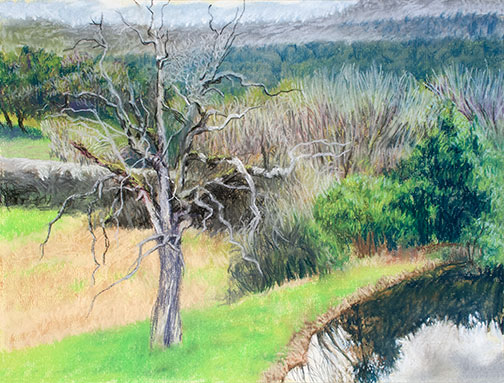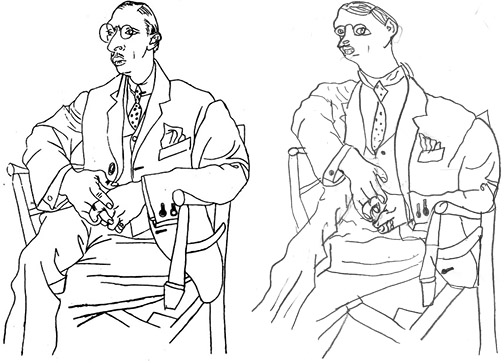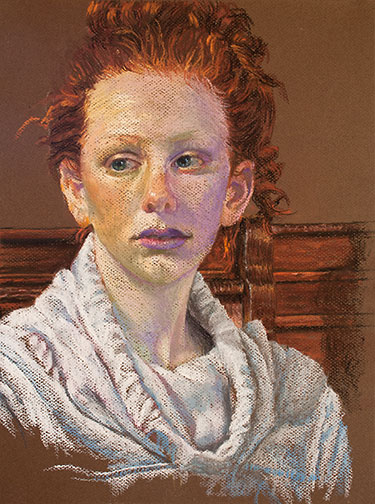
I haven’t created a pastel portrait in a while, so I thought I’d walk you through the process involved in creating this one.
It was started live, during a Yosemite Western Artists (YWA) model session. YWA is the only artist group up here in my area of the California side of the Sierra Nevada Mountains. I live in the foothills, just south of Yosemite National Park. Luckily, they sponsor a lot of art activities including weekly 3 hour live model sessions, monthly plein air outings and photography group get togethers, as well as the annual Tri-County art competition and exhibit. This particular Friday, a young woman named Priscilla Bugg, who has been posing for the group since she was a little girl, was our model.
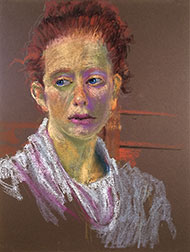
It began pretty humbly. Our models pose for 20 minutes, then take a 10 or 15 minute rest break, then pose again for another 20 minutes, etc., etc., so of the 3 hour session, you only get about 2 hours of actual painting time. I like to add a few strokes, step back and see how what I’ve done compares to what’s up on the model stand, add a few more strokes, step back again and see how what I’ve done compares to the model…you get the picture. If I get a whole painting roughed out by the end of the session, I’m happy.
Invariable, no matter how carefully I sketch out/layout my subject, prior to actually painting, I don’t notice where my drawing is off until I have all the 3 dimensional forms blocked in. That’s when I realize things like the face is not wide enough or too wide or the nose is too big or small. I believe this has to do with the fact that the layout is just outline. Once you add form to outline it changes. For example, take a look at the line drawn and form rendered pipes below. Both are exactly the same size and shape, yet the form rendered version appears smaller in diameter (they ARE supposed to be pipes!) then the line drawing.
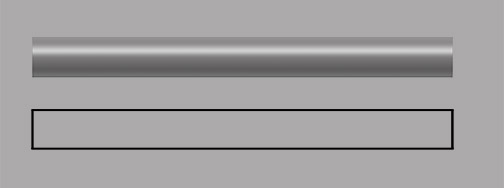
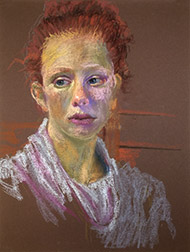
So, when I got to the studio, put the day’s pastel painting on the easel and compared it to the reference photos I’d taken, I could see a lot of the forms were off. I set to work by raising the height of her forehead, reshaping her eyes and I began widening the left side of her face, at the cheek bone.
The big difference in working with pastels when compared to other mediums, is the fact that you can’t mix custom colors on a palette, prior to applying them to your painting. You can mix all the custom colors you desire with pastels, however, you have to mix them on the painting itself. This takes a bit more planing as you work. You’ll often see me applying garish colors on my first or second pass. I do this knowing they’ll be made more subtle with later passes. If I don’t apply those purples, blues and greens with my early passes, the subtle version of those colors won’t be there, when I’m finished.
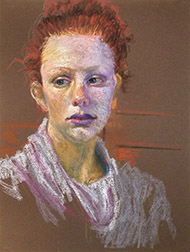
During my next session I added more detailing to and around her eyes. I also reshaped and detailed her mouth (including the Lauren Hutton gap between her teeth, cute!). The rest of my time, that day, was taken up with modification of the facial colors and values overall, adding a lot of pale pinks, oranges and yellows to neutralize the greens and purples a bit. Her face is really starting to have volume.
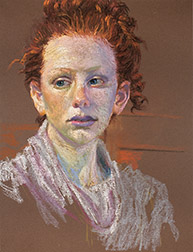 Another session, a longer one, and I had time to make a lot of progress. I finalized the shape of her face, made more changes to her facial skin tones, did a bit more work on her mouth, did a lot of work on her hair (I changed the shape and I added darks and lights) and I began to work on her neck with some new cool pale blues and some lights. I also reconstructed her ears.
Another session, a longer one, and I had time to make a lot of progress. I finalized the shape of her face, made more changes to her facial skin tones, did a bit more work on her mouth, did a lot of work on her hair (I changed the shape and I added darks and lights) and I began to work on her neck with some new cool pale blues and some lights. I also reconstructed her ears.
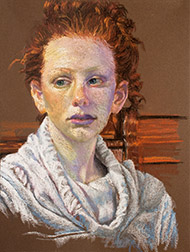
In this, the 2nd to the last session, I added a bit more warmth (warm colors) to her face, pretty much finished all the detailing on her neck and then began detailing the hooded sweatshirt she’s wearing. I also started working on what is showing of the chair she’s sitting in and the other woodwork behind her.
My work during the very last session took her to the finish, shown at the top of this post, and included the final detailing of the woodwork behind her and finicky touches here and there overall. She really went through a lot of changes from the initial sketch of Priscilla live to my last, in studio, session. They don’t always change this drastically, but when they do, I think it makes for a more entertaining ride for the viewer!

